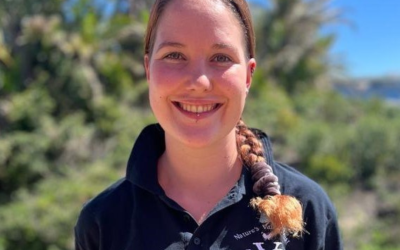 Nurdles are so small that even when you’re looking for them they can be hard to see.
Nurdles are so small that even when you’re looking for them they can be hard to see.
Someone with an interest in ocean or coastal conservation may have heard of a nurdle, a common type of microplastic, but outside of this realm, they are still relatively unknown. In the plastics industry, they are better known as polymer granules or pre-production plastic pellets, but they are all broadly the same thing: minuscule blocks or oval pellets of translucent polyether plastic about the size of a lentil. These granules are sold, by the tonne, to plastic manufacturing companies as a raw material to be melted and moulded into the majority of plastic products we use in daily life.
As nurdles are essentially the main ingredient in plastic production they are the forebearer of all the cheap, disposable plastics that have in recent months become mainstream news as they clog up the ocean systems and litter the coast. However, the effects of this kind of plastic pollution on marine life and the food chain are well-documented so let’s, for now, ignore the fact that nurdles are the parents of the plastic bottle and concentrate on their pollutive effect in their own right.
Firstly, nurdles become toxic once they are in the water. An EU study in 2013 showed that the soft polyethelene material used in many nurdles acts as a sponge to certain pollutants. As nurdles are so small they collectively make up a very large surface area and therefore a lot of space for toxic compounds to adhere to – far greater than if the plastic was in one block. Plus, just like other plastics, nurdles can be broken down under UV light from the sun over time which further increases the surface area. Two common chemicals that are regularly deposited in the ocean through agricultural and industrial processes were looked at in the study; polychlorinated biphenyls (PCBs) and polycyclic aromatic hydrocarbons (PAHs). Both were commonly found attached to nurdles, with both increasing in concentration the longer the nurdles were left in the water. The details of these individual chemicals can be found online but for now it is only important to know that both chemicals bioaccumulate up the food chain and both are carcinogenic to humans.
Next, as mentioned, nurdles are round, small and translucent. In fact, they look incredibly similar to a fish egg. Once nurdles enter the ecosystem they are routinely eaten by small seabirds, such as terns and shearwaters, and fish, like the Atlantic cod, because they look, and begin to smell, exactly like food. However, researchers have also found these pellets in crabs, mussels, sea cucumbers, scallops, barnacles and many other base food sources. As with all plastics, they cannot be broken down by the animals that eat them and so the now toxic pellet sits inside the unlucky bird, mollusc, or fish causing liver damage, endocrine disruption and other issues. Should these be eaten by something higher up the food chain, the pellets, along with their package of poison, go with them and end up in the stomach of someone new. As the nurdles accumulate the level of poisoning increases until eventually, the animal dies. Any of these fish or mammals that are caught for human consumption first will have these toxic chemicals in their flesh.
 A single nurdle and a fish egg can be easily confused. Research is being done into how nurdles may also take on a confusing organic smell too.
A single nurdle and a fish egg can be easily confused. Research is being done into how nurdles may also take on a confusing organic smell too.
So we have the perfect storm: an object that is so tiny that once spilt it is incredibly difficult to clean up, that looks like food, that absorbs toxic chemicals and cannot be digested. But how do they end up in the ocean? Nurdles are small and bouncy. Consider pouring lentils from a bag into a pot and spilling some – you’ll be finding lentils in corners of your kitchen for a month. The same thing can happen in the plastic industry. Forklifts carrying sacks of nurdles spill a bit here and there, an outdoor area isn’t swept properly before the rain washes a spillage right into the drain and so on. There are also high-impact accidents; in 2015 containers with 150 tonnes of plastic nurdles were blown from a port in Hong Kong into the ocean during a typhoon. Around half was recovered. In 2017 hurricane winds threw a container of 49 tonnes of plastic nurdles into the waters just off the coast of Durban. This week, a year later, I found some of those pellets in Nature’s Valley as I conducted a marine debris survey.
Global demand for cheap plastic is still increasing and with almost all plastic products beginning life as a nurdle it seems that these issues can only get worse. Some have argued for stricter plastic policies or better enforcement of the current ones. But attempting to force better management of a clearly dangerous product may not be the most effective path. Perhaps what needs to change is the level of demand coming from our convenience-addicted society. Whilst individual action can seem like a drop in the ocean when working against multi-national issues, it is only through reducing market demand that plastics may begin to become less profitable. Perhaps my refusing to buy bottled water will do nothing at all. But what if you refused too? What if your family refused? What if their friends joined in? And their friends’ families. Perhaps a drop in the ocean is all that is needed to start the ripples of change that our oceans so badly need.

Seabirds eating plastics: https://www.nurdlehunt.org.uk/whats-the-problem/eaten-by-animals.html
EU study: http://ec.europa.eu/environment/integration/research/newsalert/pdf/326na6_en.pdf
Nurdle sales: https://www.made-in-china.com/products-search/hot-china-products/Plastic_Granule.html



